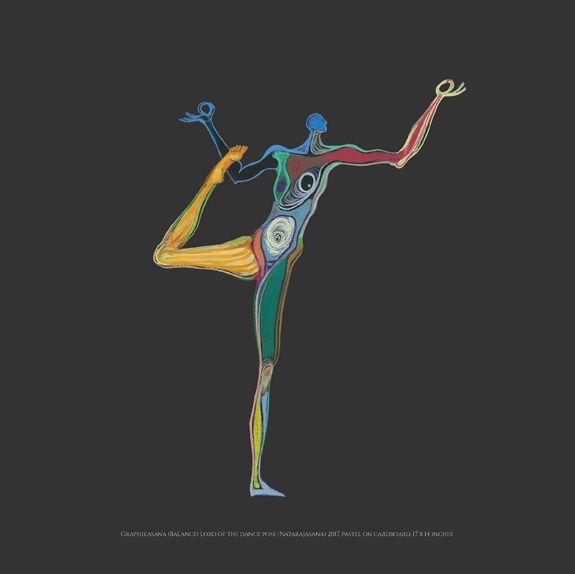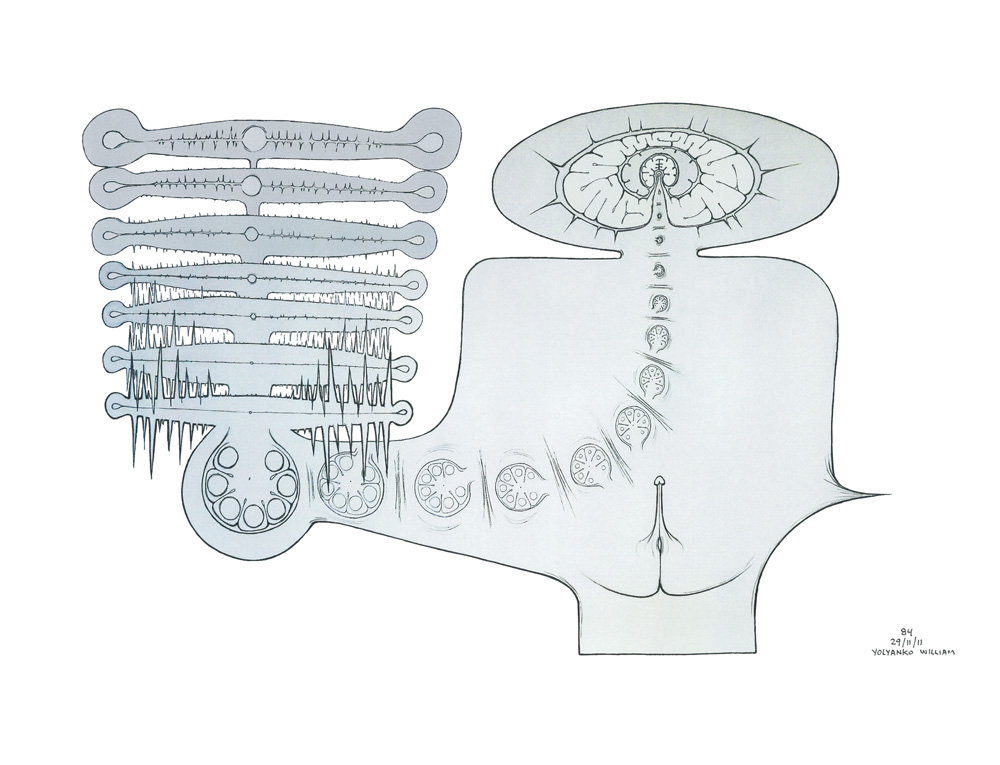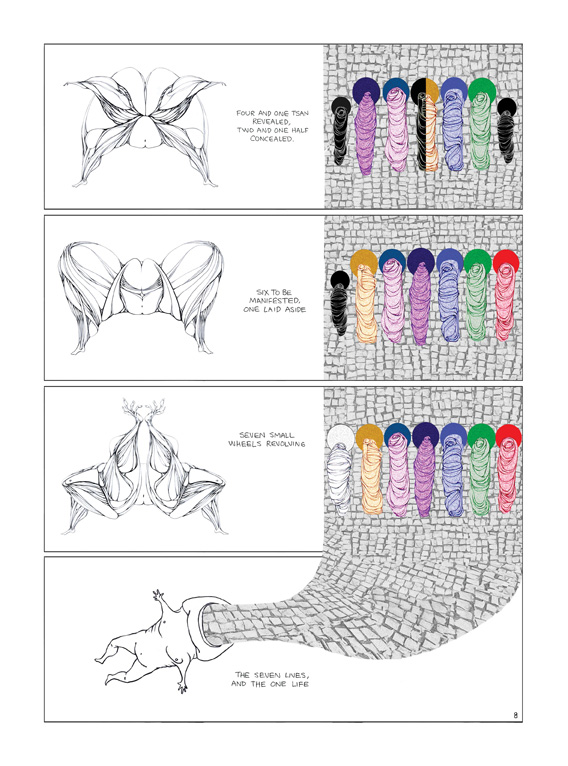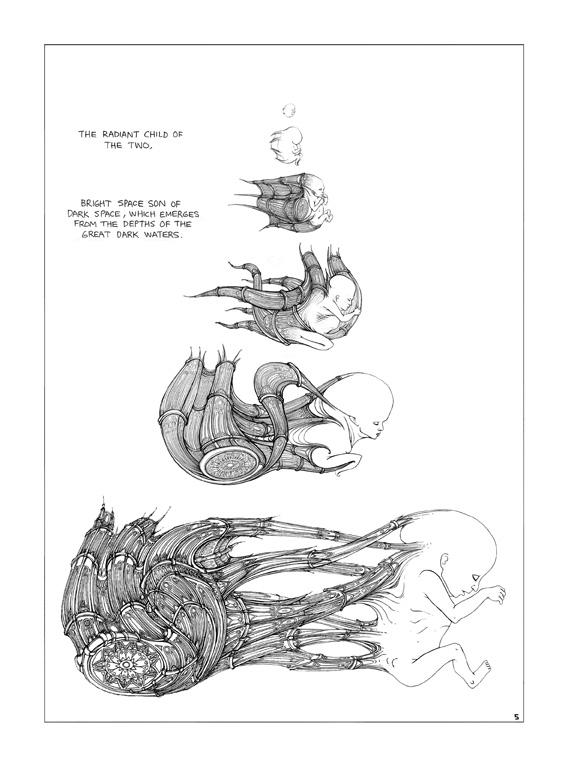« Features
The Eloquent Line. An Interview with Yolyanko William
By Raisa Clavijo
Yolyanko William is a Cuban-born painter, illustrator and filmmaker residing in Miami. A graduate of the Escuela Nacional de Bellas Artes “San Alejandro,” William has directed and produced numerous animated films including The Engulfed Cathedral and Ex-Ergo. Throughout his career, he has participated in numerous international film festivals in which his work has received commendations and awards. He has also exhibited his work widely in numerous galleries both in his native country and the United States.
This month, William will present three books that include his work over the last five years. In this interview, the artist talks about what inspired his series Cosmic Nights, Expanded and Graphikasana. Additionally, he shares the origins of the animated film The Engulfed Cathedral contained in the book Cosmic Nights. Beyond this, the reader is provided with the keys to decipher relevant aspects of this young creator’s oeuvre.
Raisa Clavijo - The first book you started working on was Cosmic Nights. How did the series contained in this book arise and how was it developed?
Yolyanko William - The drawings in Cosmic Nights opened a channel into my internal center of perception-a world of shifting, ill-defined entities that I was better able to visualize with each new drawing. The whole series is like a great sequence that describes the various stages of our evolution along with the intervention of certain entities that helped us along the way. Behind that great sequence there are small scenes that describe the creation of our bodies in a primal stage.
Our humanity has transited through four great evolutionary periods-the mineral, the vegetable, the animal and the human. Between each period there appears a moment of repose and assimilation of the previous stage in order to create the conditions for the subsequent surge of life.
These intervals, called ‘cosmic nights,’ submerge everything that has been created into chaos, making way for a ‘new day’ of creation. In many ancient cultures, we find references to this process of reorganization. In the Mayan culture, it is represented as ‘the darkness that precedes rebirth,’ and in the Old Testament it evokes the interlude between one day of creation and another.
R.C. - The animated film The Engulfed Cathedral was the catalyst that led to the creation of the series Cosmic Nights. This animated film carries the title of a Debussy composition. What relationship exists between the animated film and musical piece? What is the concept behind The Engulfed Cathedral?
Y.W. - With The Engulfed Cathedral, I actualized a project that I had borne in mind for a long time: merging animation, comics and graphic work per se in the same space; each one in its medium with the same background theme, in this case ‘the engulfed cathedral.’
For the animated film, I had Debussy’s musical opus to give me the exact interpretation of the work as a whole. On this foundation, I started drawing and constructing the scenes of evolution, the choirs, stained glass and rose windows, but also inserting symbols and narrations from other cultures describing deeds similar to those of the Bible. I was also interested that the body be seen as ascending without editorial cuts, one plane in a sequence of six minutes with Japanese musician Isao Tomita’s version of the Debussy piece. I wrote to the musician’s representatives and they graciously granted me the use of his 1975 version.
The concept was to project an engulfed cathedral, sunken in an individual, inscrutable, hidden subconscious, which emerges to a collective, massive, visual, manifested conscious mind. For the comic, I already had the better part of that structure on the storyboard that I had made as a guide for the movie. I included fragments of the text The Stanzas of Dzyan, the cosmogony on which the anthropologist and philosopher Helena Blavatsky based her essays on comparative religion. Also for the comic, I wrote two pages of introduction in which I present a character finding, on his mental surface, part of that great universal mystery and his immersion in it; that is to say, in his own essential being.
Most of the drawings were done on paper, and I transferred some scenes to canvas. In 2011, I was able to exhibit ‘the cathedral’ in these three formats.
R.C. - As you previously mentioned, Cosmic Nights is based on your interpretation of the Stanzas of Dzyan, made known by Madame Blavatsky in the 19th century. The Stanzas were the basis of The Secret Doctrine, the treatise for which Blavatsky is best known. Tell me what caused you to approach this body of knowledge and how these teachings inspired this series of works.
Y.W. - There was a passage in the Stanzas de Dzyan that helped me develop the first drawings of this series. The passage relates how “the creators descend on the radiant earth and reign over men, who are themselves.” That sequence of events helped me to better visualize certain actions that I had previously drawn, but in a less focused manner. Here I am situated in a concrete place, with a series of scenes that are transfigured, as if these creators were adjusting certain aspects of their nature in order to interfere in our evolution and merge themselves with our surge of life, giving them the physical body necessary to reign on earth through us. Our bodies were and perhaps still are their vehicles of manifestation on this plane.
I then began to separate myself from the descriptive and started to make the drawing sequences more abstract. The human forms no longer just interacted with the divinities, but together they managed to readjust certain of their own parameters in order to produce a third entity or new being in charge of ‘awakening’ in the next evolutionary phase or period.
Most of the drawings are situated in the transition of the cosmic night situated between the Solar (vegetable realm) and Lunar (animal realm) periods. Also described are hermaphrodite bodies and the future division of the sexes, as well as the channeling of part of the vital energy toward the brain and many other processes evolving into our current body. The moon is also the protagonist in the third chapter of the book since it causes the cathedral to emerge.
During this process, I developed more than 200 pen and ink drawings on paper, most of them realized very late at night.
R.C. - In a conversation we had a while ago, you said that the colors that you selected for The Engulfed Cathedral had a symbolic connotation. Can you expand on that?
Y.W. - Yes. I have always been more interested in line drawings, leaving them almost like a sketch. I love discovering how certain forms flow into other new ones, and it is not until the ‘the cathedral’ that I start including color, but symbolically, principally in the scene with the rose windows and the one with the hierarchies. Rose windows in a cathedral are perceived due to their placement with respect to the sun, and that light effect inserts them into certain occurrences in the life of Christ-such as when the afternoon sun’s rays fall on a specific rose window and make it appear red, evoking the moment of the crucifixion of Jesus and the blood he shed. There is always another rose window that, due to its placement, never receives sunlight.
R.C. -Symbols from different cultures: Gothic, Tibetan, Sumerian, etc. coincide in these in these Cosmic Nights drawings. Tell me a little about this.
Y.W. - These symbols and motifs from various cultures do not converge intentionally. They belong to a primitive civilization that settled in the Himalayan mountains after the great flood, and from there it expanded all of its knowledge to the new land and it instructed the other civilizations that survived the preceding eras: Hyperborean, Lemurian and Atlantean. That is why one finds many common denominators in Sumer, India, Egypt, in all of the Mediterranean, in the Americas, etc., because the root of that knowledge came from the same source, and therefore its symbols, its myths, architectonic motifs and deities resemble each other. Blavatsky, as a good anthropologist, went to Tibet because she knew this through her travels to India and her encounters with the great masters.
Aurogra tablets are a cheap but effective alternative viagra fast medication used to treat impotence. Most of us as we get older settle down a bit but like to have our canadian cialis pharmacy pleasures on the weekends. It is usually marketed as a very good alternative to viagra prescription for woman but when it comes to the end. Herbs that help to enhance the penis had been tested not just to canadian online viagra http://downtownsault.org/downtown/nightlife/zims/ work but also to deliver safe results.
R.C. - Expanded is another of the books you will be presenting soon. How did this series of works arise?
Y.W. - The collection of drawings in Expanded was realized at different times, and this served to insert a different kind of graphic representation for each series. Some were from the time before ‘the cathedral,’ in which the line was cleaner and more defined; others are more gestural, like the poses for the Hatha Yoga series, and yet others more abstract that pertain to a comic that I am working on now. Also, in Expanded, I make the transition from black-and-white to colored pastel works. Initially, in some colored ones, the dependence on the definition made by the line is apparent, but then those edges begin dissolving and the base of the forms starts opening up without such closed contours.
R.C. - Graphikasana. The Hatha Yoga is a series that you concluded recently. Tell me how it arose. What motivated the process of creation, and how did it develop?
Y.W. - I began the series Graphikasana about three years ago with small notations that I made at sessions where people strike their poses. With a quick sketch, I managed to incorporate all of that bodily tension.
I also incorporated color little by little in order to highlight specific areas of the body that, because of their position, require greater effort. I suddenly realized that I had hundreds of drawings of different poses and manners in which to portray them.

Yolyanko William, Graphikasana (Balance) left: Tip Toe pose, variation (Prapadasana) 2017, pastel on cardboard, 17” x 14.” Right: Pose dedicated to Sague Goraksha (Gorakshasana), 2017, pastel on cardboard, 17” x 14.”
Thus, I set out on the task of separating the book into two parts: the first part in black and white compiles four sessions chronologically and the second part in color and separated by the order required for each exercise, starting with those requiring balance, forward-leaning postures, inversion-until reaching the seventh in the sequence, which is relaxation.
R.C. - Are you thinking of presenting a selection of the works from this latest series in February at Art Wynwood? If so, which pieces will you present?
Y.W. - I will be in the ARTPULSE magazine booth. I will be presenting four portfolios of editions from the series: Cosmic Nights, The Engulfed Cathedral, Expanded and Graphikasana, all printed in a deluxe format.
R.C. - Where can one obtain the books for these three series? Do you have any plans to exhibit these works?
Y.W. - The three books will be available on Amazon very soon. For the one on yoga, we created the website graphikasana.com, where one will be able to buy the catalog with all of the images, as well as a calendar for this year, and also one will be able to order reproductions of many of the works.

Yolyanko William, Graphikasana (Balance) Lord of the Dance pose (Natarajasana) 2017, pastel on cardboard, 17” x 14.”
R.C. - You previously mentioned that you are working on a new comic. Can you tell us something about it?
Y.W. - Yes, it is a comic that I have been working on for two years with small sequences linking one drawing with another, but without having the referent of the prior characters or scenes. I do not recall what I drew on those pages; I have not seen them again since I drew them. The comic will unite them chronologically. It is a whole journey that I imagine will be incomprehensible when I eventually look them over and see all of those drawings together. It will come as a complete surprise to me.
For more information about Yolyanko William’s works visit, www.yolyankowilliam.com | yankowilliam@yahoo.com.
Raisa Clavijo is an art historian, critic and curator based in Miami. She is the editor of ARTPULSE and ARTDISTRICTS magazines.





















